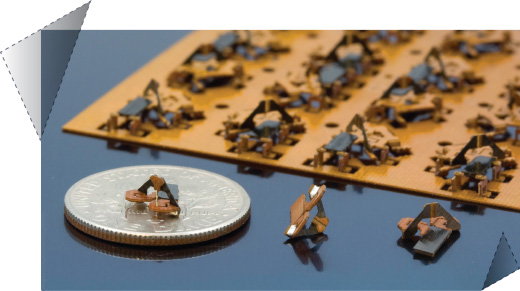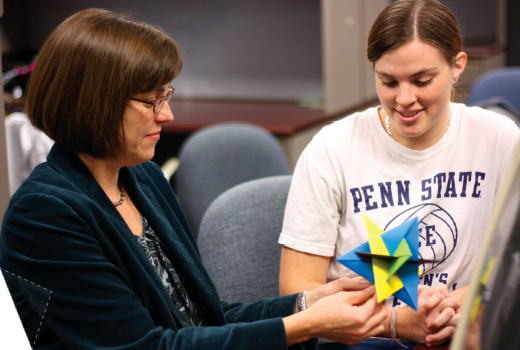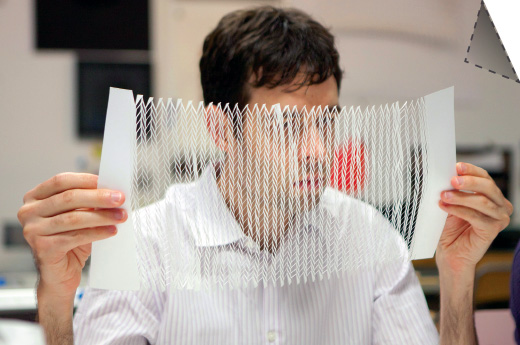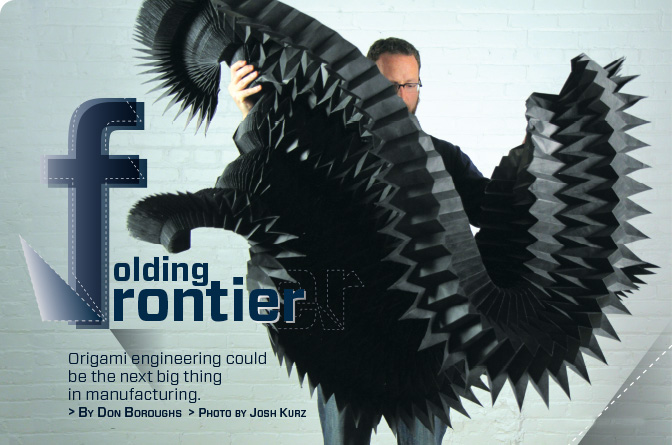Folding Frontier
Yes, the engineering research of David Gracias does resemble the hobby of folding paper. And the way, under his microscope, nano-materials fold themselves into cubes and pyramids, like tiny polyhedrons coming to life, seems Disney inspired. But please don’t say it’s cute. “I hate the word cute; I’m not in the business of doing ‘cute,’” protests Gracias, associate professor of chemical and biomolecular engineering at Johns Hopkins University. Until recently, “origami was treated like a game,” he says. The pioneers who incorporated the ancient Japanese art into high technology were both lonely and frequently mocked. “That a real scientist could do something useful with it was treated with skepticism. They would say, ‘How cute.’” Recalls University of Illinois at Urbana-Champaign civil engineer Glaucio Paulino: “People did not believe in this idea. They said it looks funny.”
No longer. With practical implications ranging from minimally invasive surgical aids to highly efficient capture of solar energy and giant space telescopes that fit into a small payload, origami engineering has evolved into a well-funded fount of innovation. In 2009 the Gracias Laboratory created the world’s smallest precisely patterned cube, a self-folding structure just 100 nanometers long on each side. Two years later, in a collaboration with researchers at the Johns Hopkins Medical School, hundreds of self-folding microgrippers were deployed and then retrieved to successfully biopsy the bile duct of a live pig. These were the world’s first untethered submillimeter surgical devices.
Origami’s growth took a new turn in 2012, when the National Science Foundation launched the Origami Design for Integration of Self-assembling Systems for Engineering Innovation (ODISSEI) program and granted some $16 million to 14 universities, with millions more to come. Paulino, who helped raise the mast of ODISSEI, says the NSF was looking for “the next topic in engineering — a vision toward the future,” adding, “We felt origami was such a project.” One of the grant recipients, Max Shtein of the University of Michigan, strongly concurs. “We’re wading into a sea of possibilities,” says the materials science and engineering professor. “There are a million different applications for engineering out of this stuff.”
What these researchers are producing, however, rarely bears any resemblance to a Japanese paper crane. Engineers typically fold sheets of shape-memory alloys or polymers into three-dimensional devices. The differences between these materials and paper highlight both the challenges and the possibilities of origami engineering. Unlike paper, these sheets can be coated in semiconductors and programmed to fold themselves. “We envision smart sheets, so that if you need anything you just tell the sheets, ‘Make me a plate or make me a cup; make me a chair or make me a tool,’ whatever that tool is,” says Daniela Rus, director of the Computer Science and Artificial Intelligence Laboratory at the Massachusetts Institute of Technology. Rus, along with engineering and math colleagues at MIT and Harvard, has already produced a small, hinged sheet that can fold itself into a boat and then into a paper-airplane shape.
But also unlike paper, most of these materials have meaningful — and troublesome — thickness. Paper creases; a polymer or a metal can at best make a tight bend. MIT mathematician Erik Demaine has been modeling origami math for more than 15 years and even earned a MacArthur “genius grant” for “solving difficult problems related to folding.” One of his early publications proved that “everything is foldable,” according to Demaine. “If you have a large enough sheet of material, you can bend it into any shape you want.” But, Demaine admits, “almost all the math models assume no thickness — we need algorithms to model thickness and minimize it in folding.”
Still, engineers are finding they have much to learn from the artists who work in paper. Shtein’s desk in Ann Arbor, Mich., is scattered with folded paper forms created by a collaborator from U of M’s School of Art and Design, Matt Shlian. “Watch this!” the engineer exclaims as he stretches a tessellated sheet of mountains and valleys that undulates in the air and then collapses between his palms. Shtein says that his own expertise in engineering materials had flattened his worldview until he began working with the artist. “He had three dimensions kind of hard-wired into him,” according to Shtein. Now he heads a $2 million NSF-funded research project, collaborating with four other engineers and Shlian to explore the folding of thin films into photonic devices.
The ODISSEI grant prospectus compelled engineering teams to find artistic coinvestigators, which was a mental stretch for some. “I was skeptical about stepping outside of our sandbox,” confesses chemical engineer Michael Dickey of North Carolina State University. Then he spent an afternoon touring the College of Design on campus. “I was surrounded on every side by 40 or 50 artistic costumes, each folded out of a single sheet of paper,” Dickey recalls. He snapped photographs on his phone and returned to the lab with three or four new ideas to apply to NC State’s ODISSEI research project. “I’m a convert,” he adds.

Daniela Rus of MIT is working on materials capable of autonomously changing their geometric and mechanical configuration, integrating sensing, actuation, computation, and communication. IMAGE COURTESY OF DANIELA RUS, MIT
Science with a Toy
The eight groups funded by the NSF take a wide range of approaches toward folding. The NCSU team uses light to heat ink-jet-printed lines on prestressed polymer sheets. The ridiculously cheap and simple process, discovered through serendipity by a team of undergraduate and grad students, leads to forms that appear to be assembled by magic, like a time-lapse film of a flower folding up for the night. At present, their raw material is a children’s craft kit, Shrinky Dinks. The researchers fold Shrinky Dinks in order to test models for the scaling laws and mechanics of folding. “It’s basic science with a toy,” says Jan Genzer, the NC State engineer in charge of the project.
At the other end of the spectrum, Texas A&M is working with a material so complex that the engineers occasionally have to laugh at the difficulty of the task before them. In fact, they still have to invent it. But the computer models developed by aerospace engineer Darren Hartl show great promise for a sandwich of two sheets of shape-memory alloy — prestressed to fold in opposing directions — separated by an insulator. A switched resistor network pattern, like a programmable version of the defrosting wires embedded in an automobile’s rear window, will trigger the bending action. With no hinges limiting the position of creases, the massively foldable sheet could theoretically take one of an infinite variety of shapes, unfold, and then refold into something completely different. In a simulation recently published by Hartl, mechanical engineer Richard Malak, and their colleagues, the sheet becomes an airfoil to steer a spacecraft to a landing on Venus, and then curls into a cylinder to roll on the planet’s surface.
Which of the many technologies will prevail in origami engineering remains a very open question. Penn State’s Mary Frecker has an ODISSEI grant to develop the Dagwood of origami sandwiches: layers of different materials that respond to magnetic, electrical, and thermal stimuli. Each layer will be preprogrammed to assume particular shapes. In Cambridge, Mass., Rus of MIT and Harvard’s Robert Wood use hinges of shape-memory alloys actuated by electrical signals. The hinges are arranged in a pattern known to origami artists as a box pleat, a grid of squares divided by alternating diagonals. Rus, Wood, Demaine, and their students have developed an algorithm that can approximate any three-dimensional shape out of a single box-pleated sheet. “I view this as the next frontier in programming,” says Rus. “Not programming bits and bytes, but shape.”

Mary Frecker and graduate student Adrienne Crivaro discuss the design of a three dimensional origami structure. IMAGE COURTESY OF MARY FRECKER, PSU
Another Harvard-MIT collaboration is folding entirely new concepts into the framework of origami. The Buckliball caused quite a stir when it was announced in the Proceedings of the National Academy of Sciences in 2012. This soft-rubber sphere with 24 precisely spaced dimples can collapse to approximately half its volume without fundamentally changing shape. The secret is a cascade of folding ligaments between the dimples. The technology was inspired by a toy, the Twist-O, brought to MIT’s Pedro Reis by a student. The Twist-O accomplishes the same trick, but with 26 structural parts and 48 rotating hinges, manipulated by hand. The Buckliball is of one piece, printed on a 3-D printer, and transformed automatically by air pressure. Unlike paper folding, this technology bypasses 2-D entirely. But, says Reis, “origami is a language that helps us explore the new framework.”
Katia Bertoldi of Harvard’s engineering school sees broad potential for what she and Reis call “Buckligami.” She is currently determining the optimal packing structure that would turn thousands of buckling balls into a new impact-absorbing material. Reis is exploring an asymmetrical version that could operate as a soft robot without motors or hinges. At the nano scale, a Buckliball with holes instead of dimples could be triggered to release medicine inside the body exactly where it is needed.
Many origami engineers are pointing their folds toward the market for medical devices. Origami has two virtues that make it well-suited to surgery. The first is that by folding compactly, origami-based devices can be minimally invasive en route to their destination in the body, expanding on arrival. This is the idea behind an origami stent that went into animal trials in 2012. Developed by Oxford University engineer Zhong You, the stent is a one-piece cylinder of titanium-nickel foil that collapses along helical and cross folds to half its full diameter for insertion. Existing stents are made of wire mesh, and their porosity complicates their function inside the arteries, according to You.
The second advantage of folding surgical structures is their Swiss-Army-knife potential to accomplish more than a single task without having to withdraw one device and insert another. “The challenge in surgery is access,” explains Gracias of Johns Hopkins. “The ultimate frontier is to have small robotic structures,” he adds, “to ‘swallow the surgeon.’”
Origami carries the exact same advantages to another frontier: outer space. When the Lawrence Livermore National Laboratory (LLNL) came up with the idea of a space telescope that would dwarf Hubble, they approached Robert Lang, a trailblazer in origami art and science. Lang has nearly 50 patents in lasers and optoelectronics, but he left his research position at high-tech JDS Uniphase Corp. in 2001 to devote himself full time to origami. Today he rotates between folding commissioned artworks and consulting as an origami engineer. The same mathematical algorithms he developed to fold an elk from paper also worked when he consulted for a German automotive engineering company to improve its simulations of airbag folding.
The LLNL’s design for the Eyeglass telescope called for a lens 100 meters in diameter — larger than a baseball field — but it needed to fit into a spacecraft payload only 4 meters wide. With the lens divided into panes, Lang helped the laboratory devise a way to fold the lens for transport and unfold it for deployment. “If you have something big and flat and it needs to get smaller, or to take on particular shape, that problem is already pretty similar to the origami problem,” says Lang. “Engineers faced with similar problems can find solutions that already exist in origami.”
The Eyeglass team built a prototype nearly as high as a two-story house that worked as predicted, but the giant space telescope has not been funded. Lang sees this process being equally useful on Earth, however. For example, he questions why people should have to carry both an iPad and an iPhone when an origami smart phone could unfold into a tablet.
Shtein at Michigan sees new markets for materials composed of microscopic folds that manipulate light. He grabs a large, yellow sheet of paper, scored with slits, and begins to tug at the edges. “Woo-hoo!” he cries as the strips of paper rotate into a honeycomb-like lattice. He envisions similar structures in nanoscale films. “If the folds were sized to correspond with the wavelength of light, it becomes a photonic material,” he notes. Or if somewhat larger, such a material could act as a Fresnel lens and might focus the moving sun onto solar cells, “like a myriad of sunflowers a millimeter or smaller,” Shtein says.
He also predicts that folded nanofilms will create colors without pigments or paints, an attractive proposition for nearby automobile companies. Butterflies and mother-of-pearl get their colors exclusively from microscopic structures that reflect and refract light, he explains. “If we could create surface features that give colors without paint, we might save a lot of the energy involved in making a car,” Shtein adds.
Paradigm Shift
In manufacturing, origami’s new frontier is to create devices — particularly very small ones — that self-assemble from rollstock, leveraging the electronics industry’s expertise in patterning minute two-dimensional detail. “This is a paradigm shift,” says Gracias. “No company is currently manufacturing things by making them assemble themselves.”
Some of the first experiments take their cue more from pop-up books than from origami. Brigham Young University’s Department of Mechanical Engineering has spun off a company to market an injector they developed to insert DNA into a single mouse zygote cell. BYU’s prototype is composed of two micromachined layers of polycrystalline silicon. In operation, the hinged needle assembly rises from the base structure onto supports and then projects forward into the egg, powered by torsion stored in the structure. The entire device could fit through the eye of a sewing needle. Because it pops up out of flat layers, Larry Howell and his BYU colleagues have termed such a machine a Laminate Emergent Mechanism, or LEM, but the coinventor of the nanoinjector also refers to it as “kinetic origami.”

Anastasios John Hart examines a paper mesh. IMAGE COURTESY OF LAURA RUDICH, COE COMMUNICATIONS AND MARKETING
Pratheev Sreetharan believes that one day everyone will use products made with pop-up manufacturing. Sreetharan, who received an ASEE-administered National Defense Science and Engineering Graduate fellowship, recently completed his Ph.D. at Harvard’s School of Engineering and Applied Sciences. He has founded what may become the first major origami engineering company, Vibrant Research. The venture was spawned by his work in Professor Wood’s robotics lab, building miniature flying robots. Assembling these RoboBees, just 18 millimeters from head to tail, was a “horrible, horrible, horrible process,” according to Sreetharan, that took a year of training and weeks of assembly. He would create 22 folds on a dozen parts, using tweezers under a microscope, and then glue them together. Most of the results ended up in the trash.
Out of this frustration, he developed a system that put all of the parts into a single sheet, laminated from 18 laser-cut layers. The key innovation was to incorporate a scaffolding structure that could act like a host of tweezers lifting and folding the layers into position in a single motion that takes less than a second. Suddenly it was conceivable to mass-produce RoboBees using standard technology in a circuit-board foundry.
Sreetharan has now set his sights on the electronics market, and his five-person company already has corporate funding. He says the pop-up folding process fills a gap between semiconductor-based micro-electro-mechanical systems (MEMS) manufacturing, which works well up to 1 millimeter, and conventional assembly, which becomes practical for products 1 centimeter and larger. “I call it ‘mesoscale manufacturing,’” he says, “for things that are too big for semiconductor techniques but too small for tweezers.” Sreetharan adds, “There are a lot of devices that people haven’t even considered building because they did not seem feasible.”
None of these origami-engineered devices is actually in commercial production yet. And engineering researchers working on the ODISSEI projects caution that years of basic research lie between the current state of technology and the day when origami-inspired products will become common in our homes and hospitals. Referring to self-folding systems, Malak of Texas A&M says, “I see a 20-year arc of understanding systems better, understanding what the limitations are, and then getting them into engineering practice.” But the long road ahead does not dampen the enthusiasm of origami engineers at all. Says BYU’s Howell, “If we can exploit the knowledge of origami artists in other materials, it will lead to very powerful systems with unprecedented performance; we will do things no one has ever done before.”
Don Boroughs is a regular Prism correspondent.
VIDEOS:
Johns Hopkins’s David Gracias, quoted above, is featured in several videos explaining his origami research. Watch the video below for more information. Additional information and a video is available in this press release.
Category: Cover Story
